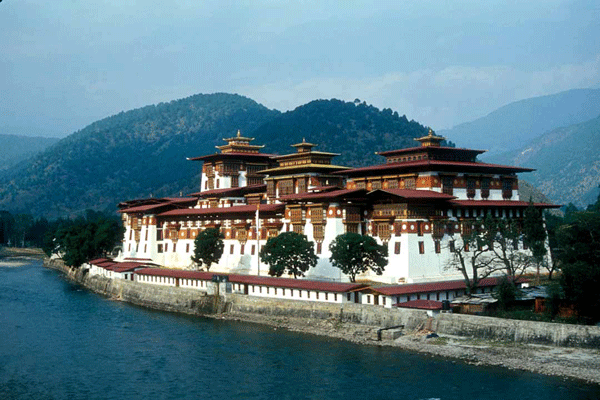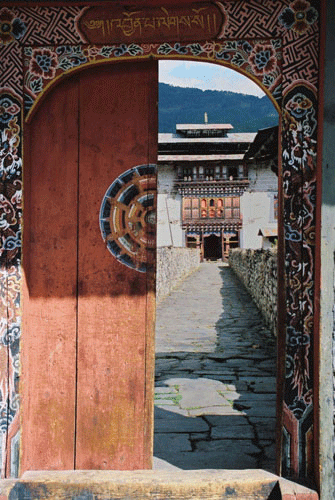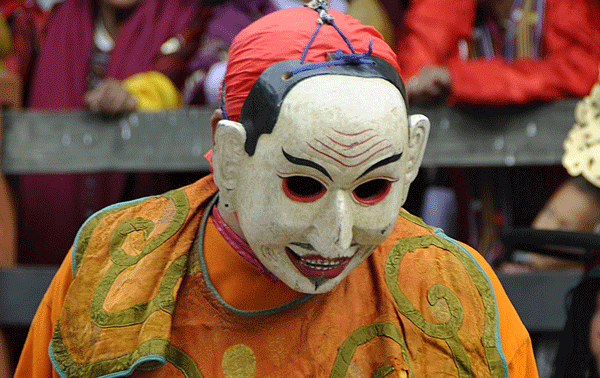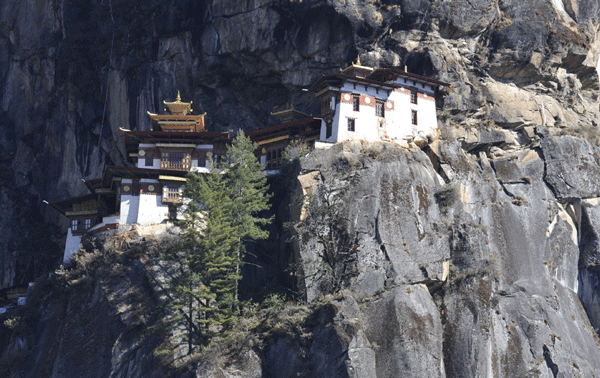Hailed as the last Shangri-La, the country of Bhutan is now becoming more accessible to the outside world. Having previously been closed to visitors, tourism to Bhutan started in the 1970’s and has been growing ever since. The country’s isolation had preserved Bhutan’s unsullied landscape giving it a direct and powerful connection to its culture.

The unique culture of this country, which is about the size of Switzerland, is evident at a glance. It’s one of the last havens of Himalayan Buddhism. The government is dedicated to preserving this culture, going so far as to institute the Driglam Namzha in 1989. This is a code that mandates the wearing of traditional garments at school, government offices, and official functions. Men wear a gho, a knee length robe tied at the waist with a belt. Women wear a kira, an ankle length dress clipped at one shoulder and tied at the waist. Bhutan is a place where you won’t see businessmen in western suits. Its architecture also remains pure, too, in that it doesn’t use nails or iron bars, instead relying on masterful carpentry. In any city in the country you will see the noticeable architecture speckled with prayer flags, making a Bhutanese city unmistakable.

Bhutan is a place dedicated to remaining untouched by time. It has one of the smallest economies in the world, with its GDP ranking 170 out of the 196 countries in the world. Despite this, Jigme Singye Wangchuck was dedicated to establishing economic self-reliance after China took control of Tibet in 1959, and brought Bhutan into the modern world as much as necessary. It joined the UN in 1971, and recognized formal diplomatic ties with India. In 2008 Bhutan held its first ever election, and drafted a formal constitution, making it a constitutional monarchy. However, these changes have not eroded the spirit of Bhutan. It is the only country to measure Gross National Happiness, and rank it above the GDP. This idea has gained popularity recently, and is being presented at the Rio+20 Summit, being described as “a holistic approach towards nations of progress,” that “places equal emphasis on a non-economic aspect of well-being.” While much of Bhutan’s economy relies on tourism, it restricts and controls it so that the environment will not be harmed in any way. Because of both this and the varied elevations in the Himalayas, Bhutan is home to tremendous biodiversity.

When you come to Bhutan, you are provided with camping gear. Nestled in the southern slopes of the Eastern Himalayas, Bhutan is a wonderful place to hike, backpack, or bike. You can witness its unravished environment first hand. If you do choose to go camping, you will be provided with a guide to show you the best locations and most sublime views. Bhutan is also one of the world’s hotspots for viewing a plethora of different kinds of flora and fauna. Because of their Buddhist reverence for all forms of life, the Bhutanese are dedicated to preserving their wonderland.
Bhutan wouldn’t be what it is if it weren’t for its many temples and monasteries. Perhaps the most famous of these is the Taktshang. This cliff-side monastery was built around the spot where the Guru Padmasambhava, the founder of Himalayan Buddhism, was said to have meditated for three months in the eighth century. Taktshang is home to many sacred relics, and serves as the sacred grounds for many religious ceremonies. There is also the Khamsum Yuley Temple. The temple is home to many pieces of spiritual artwork painted on its inner walls. Part sacred space and part museum, the Khamsum Yuley Temple is still worth a visit even if you are not interested in Buddhism.

There are also a number of festivals that take place in the many monasteries in Bhutan. Part social, part spiritual, these rituals are an example of how deeply rooted Buddhism is in the daily lives of the Bhutanese people. The festivals usually last for three days. They involve traditional folk music and intricate sacred dances performed in beautiful masks. These dances are meant to impart an aspect of Tantric Buddhism in the viewers. There is also often a utilitarian function to these festivals. For example, there is the Matsutake Festival. In it, the participants view the sacred dances in the daytime, and in the evening harvest the illustrious Matsutake mushroom, particularly valued in Japan. If you are interested in Himalayan Buddhism but don’t want to be a part of the performances, you could also visit the Malanda Buddhist college, filled with monks eager to practice their English.
The food in Bhutan might not be to popular tastes or the weak of heart. The Bhutanese treat chilies as a vegetable, rather than a spice, and are fond of putting them in every dish. The signature Bhutanese dish is called Emadatse. It is comprised of sliced peppers, either green or red depending on the chef, in a cheese sauce. The cheese is locally made, and tastes like a cross between paneer and Monterey Jack. It is served over pink rice, the only kind that grows at Bhutan’s high altitude, and is blisteringly spicy. However, the chefs are sensitive to tourists’ palettes, and are perfectly willing to tone down the spiciness of a dish by either removing the seeds of the peppers or even omitting them entirely. Basic Indian and Chinese fare are both readily available for those wanting something more familiar.

Citizens of India, Nepal, Bangladesh, and Thailand are allowed to simply walk across the border of Bhutan. Others will need a travel visa. While these visas don’t take too much time to acquire, they are incredibly specific. If you’re traveling in the months of March, April, May, September, October, or November, there is a tariff fee of $250.00/day. For January, February, June, July, August, or December, it is $200.00/day. These rates are for a group of three or more, with a higher fee for individuals or groups of two. However, this includes all the basic amenities of travel. It includes board, three meals a day, all internal travel, travel with a licensed tour-guide, and even camping equipment. Once all of this is paid for, obtaining a travel visa can take as little time as 24 hours. This might seem like a hassle, but it’s really letting someone else deal with all the hassles while you pay a simple flat fee.
Bhutan has a concern for life drawn from its Buddhist roots, and whether or not you are yourself Buddhist, you can trust them to show you happiness. After all, they measure it.
[alert type=white]
[/alert]

